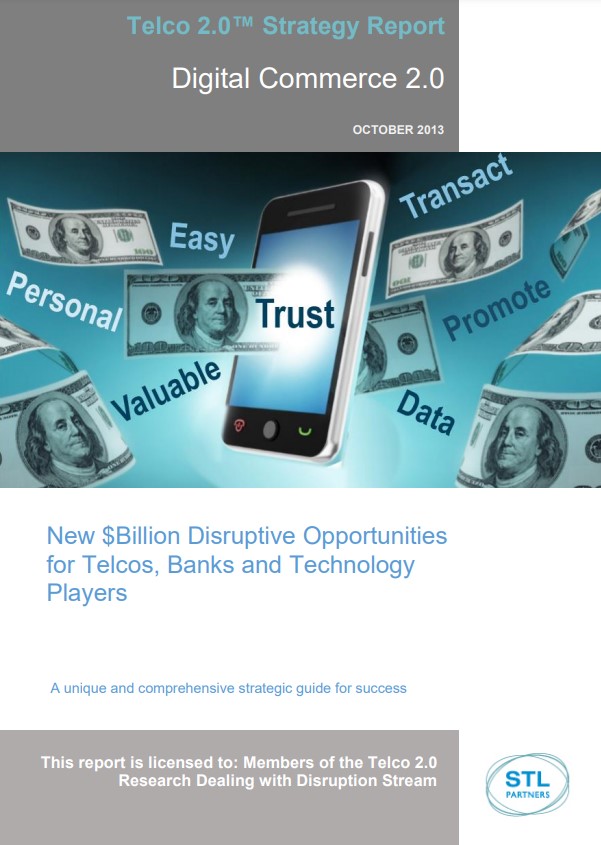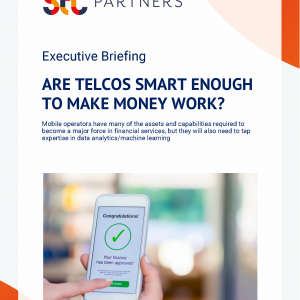Digital Commerce 2.0: New $50bn Disruptive Opportunities for Telcos, Banks and Technology Players
£1,000.00 excl VAT
Telcos, Internet and technology players, banks and payment networks have disruptive $billion opportunities to act as intermediaries / enablers in mobile commerce and personal cloud services, based on the appropriate use of customer data. This report is a unique and comprehensive strategic guide for success in these roles. It analyses the strategies of the main and cutting-edge players, and outlines key success factors in designing and delivering customer propositions, technology, organisation and value network strategies. It also includes evaluations of the related strategic opportunities of ‘raw big data’, professional data services, and internal data use, and a business model showing how one type of candidate for the intermediary role, a telco, could grow profitable new revenues equivalent to c.$50Bn (5% of existing core revenues) within five years. (October 2013, Dealing with Dsiruption Stream). Telco 2.0 Transformation Index Small
Description
Format: PDF filePages: 222 pagesCharts: 119Author: STL research teamPublication Date: October 2013
Table of Contents
- Executive Summary. (9 pages outlining the opportunity and key strategic options)
- The shape and scope of the opportunities, the convergence of personal data, mobile, digital payments and advertising, and personal cloud. The importance of giving consumers control. and the nature of the opportunity, including Amazon and Vodafone case studies.
- The Marketplace. Cultural, commercial and regulatory factors, and strategies of the market leading players. Further analysis of Google, Facebook, Apple, eBay and PayPal, telco and financial services market plays.
- The Value Proposition. How to build attractive customer propositions in mobile commerce and personal cloud. Solutions for banked and unbanked markets, including how to address consumers and merchants.
- The Internal Value Network. The need for change in organisational structure in telcos and banks, including an analysis of Telefonica and Vodafone case studies.
- The External Value Network. Where to collaborate, partner and compete in the value chain – working with telcos, retailers, banks and payment networks. Building platforms and relationships with Internet players. Case studies include Weve, Isis, and the Merchant Customer Exchange.
- Making appropriate use of personal data in different contexts. Tools for merchants and point-of-sale transactions. Building a flexible, user-friendly digital wallet.
- Potential revenue streams from mobile commerce, personal cloud, raw big data, professional services, and internal use.
- Appendix – the cutting edge. An analysis of fourteen best practice and potentially disruptive plays in various areas of the market.
Table of Figures
- Figure 1: The gap in the market: Proactive, personalised recommendations
- Figure 2: The elements that make up the wheel of commerce
- Figure 3: The personal cloud value proposition for consumers
- Figure 4: Potential revenues for a U.S. telco with 68 million subs
- Figure 5: The pros and cons of collaboration and going it alone
- Figure 6: Collaborate upstream, but go it alone downstream
- Figure 7: For European telcos, the brutal future is here
- Figure 8: Future sources of growth in the telecoms industry
- Figure 9: The STL Partners Business Model Framework
- Figure 10: The elements that make up the wheel of commerce
- Figure 11: A breakdown of the U.S. direct marketing and advertising market
- Figure 12: The relative size of the segments of the wheel of commerce
- Figure 13: Examples of financial services-led digital wallets
- Figure 14: Examples of Mobile-centric wallets in the U.S.
- Figure 15: How personal data is used today
- Figure 16: How Orange views the data generated by mobile services
- Figure 17: The data captured by telco networks is seen as valuable
- Figure 18: Trust is breaking down between the key personal data stakeholders
- Figure 19: Giving consumers control over personal data
- Figure 20: Five big data opportunities for telcos
- Figure 21: The unfulfilled gap in the digital commerce market
- Figure 22: How Telefónica compares with leading Internet players
- Figure 23: The proposed anayou mobile commerce JV in MENA
- Figure 24: Internet giants and start-ups best placed to be infomediaries
- Figure 25: How M-Pesa works
- Figure 26: Live M-Pesa markets
- Figure 27: The features and benefits of the SmartPass proposition
- Figure 28: Vodafone’s three-step strategy
- Figure 29: The self-reinforcing flywheel Vodafone is aiming for
- Figure 30: The mobile commerce strategy of leading telcos
- Figure 31: The mobile commerce strategy of leading Internet players
- Figure 32: How the fundamental Amazon flywheel increases working capital
- Figure 33: How the Amazon Payments flywheel has evolved
- Figure 34: Deals on display in the Amazon Local app
- Figure 35: Telcos have regular customer contact and real-time data
- Figure 36: Potential strategic actions for telcos
- Figure 37: Leading Internet companies have global reach and scale
- Figure 38: Potential strategic actions for Internet players
- Figure 39: Banks have local knowledge, payment networks trusted brands
- Figure 40: Potential strategic actions for banks and payment networks
- Figure 41: Google’s big lead in mobile Internet ad spending
- Figure 42: Google handles one third of all digital advertising
- Figure 43: How consumers can redeem a Google Offer
- Figure 44: Who is best placed to win in facilitating local commerce?
- Figure 45: Google Wallet no longer needs to work directly with banks
- Figure 46: Facebook’s daily active users continue to grow
- Figure 47: Facebook’s mobile daily active users
- Figure 48: Apple’s Passbook app stores vouchers and loyalty cards
- Figure 49: How the leading Internet players are positioned in mobile commerce
- Figure 50: Deutsche Telekom’s local commerce proposition
- Figure 51: The carrier billing uplift in one digital store in Hungary
- Figure 52: The Growth of New Businesses at NTT DOCOMO
- Figure 53: DOCOMO’s Smart Life Strategy
- Figure 54: DOCOMO is aiming to become a trusted advisor
- Figure 55: China Mobile’s Growing Digital Content Business
- Figure 56: Mobile wallets will take time to gain traction
- Figure 57: Most people in developing countries don’t have bank accounts
- Figure 58: Most people in developing countries are living on less than $2 a day
- Figure 59: The mobile commerce flywheel
- Figure 60: A hierarchy of needs for banked customers
- Figure 61: For banked consumers, digital wallets mainly offer convenience
- Figure 62: A hierarchy of needs for unbanked customers
- Figure 63: For the unbanked, digital wallets offer convenience and some savings
- Figure 64: Mobile commerce can help merchants build deeper customer relationships
- Figure 65: The personal cloud value proposition for consumers
- Figure 66: The personal cloud value proposition for merchants
- Figure 67: Digital services require a new skillset
- Figure 68: What percentage of your customers are advocates, antagonists, or
apathetic? - Figure 69: Operators’ understanding of their advocates and antagonists is poor
- Figure 70: Operator analytics are deemed to be poor
- Figure 71: Telcos aren’t organised for upstream engagement
- Figure 72: Five high-level steps to become customer-centric
- Figure 73: The complexity of the customer journey
- Figure 74: Vodafone’s new customer experience capabilities
- Figure 75: Vodafone cuts customer care costs through self-service
- Figure 76: Vodafone moves from retail stores to service hubs
- Figure 77: Potential strategic actions for telcos
- Figure 78: The pros and cons of collaboration and going it alone
- Figure 79: Collaborate upstream, but go it alone downstream
- Figure 80: Different compete and collaborate strategies
- Figure 81: The potential roles of telcos and banks in a mobile commerce partnership
- Figure 82: The virtuous circle Weve is aiming to create
- Figure 83: Isis enables consumers to clip coupons into their wallet
- Figure 84: Telefonica O2’s two-sided strategy
- Figure 85: The different elements of the wheel of commerce
- Figure 86: Telcos can combine data from different domains
- Figure 87: How to reach consumers: The technology options
- Figure 88: Balancing cost and consumer experience
- Figure 89: An example of an easy-to-use tool for merchants
- Figure 90: Drag and drop marketing collateral into Google Wallet
- Figure 91: There isn’t a perfect point of sale solution
- Figure 92: The proportion of mobile transactions to be enabled by NFC in 2017
- Figure 93: Integrated platforms and point solutions both come with risks attached
- Figure 94: Telcos’ potential revenue streams from a mobile commerce service
- Figure 95: Telcos’ potential major costs in launching a digital commerce service
- Figure 96: What will North American consumers value most from digital commerce?
- Figure 97: Potential revenues from mobile offers
- Figure 98: Telcos’ mobile commerce revenues are likely to be modest
- Figure 99: Potential revenues from a personalized entertainment portal
- Figure 100: Cisco’s vision of an infomediary
- Figure 101: Estimates of the costs of using personal data to drive referrals
- Figure 102: The site monitoring packages offered by Motionloft
- Figure 103: Potential revenues from selling raw footfall data to restaurant chains
- Figure 104: The potential revenue uplift for Delta Airlines
- Figure 105: Potential revenues from selling professional services to the travel industry
- Figure 106: The personal data opportunity for a U.S. telco with 68 million subs
- Figure 107: Foursquare’s SoMoLo app
- Figure 108: A decentralised architecture for the Internet of My Things
- Figure 109: Mint helps consumers track their spending
- Figure 110: Mobile currency can be used to reward the mass market
- Figure 111: Personal.com’s privacy-enhanced small data platform
- Figure 112: How Placecast is linking location-based offers to payment cards
- Figure 113: Shopkick’s automated shopper rewards – ‘kicks’
- Figure 114: Mobile Shopping Apps Average Time Spent per Month
- Figure 115: Starbuck’s mobile application doubles as a wallet
- Figure 116: Square enables merchants to customise receipts
- Figure 117: The three elements of UnboundID’s Privacy Suite
- Figure 118: ZangBeZang’s vision of personalised digital commerce
- Figure 119: A summary of the pioneers’ commercial offerings
Technologies and industry terms referenced include: Advertising, Amazon, American Express, Amex, apple, AT&T, bank, Barclays, BlueVia, business, CellPay, Cellum, China Mobile, chip and pin, commerce, data, Deutsche Telekom, digital, Digital Asset Grid, eBay, facebook, financial, Foursquare, Globe, google, GSMA, Innotribe, Internet, ISIS, KT, Kynetyx, loyalty, M-PESA, marketing, MasterCard, microsoft, Mint, MinuTrade, mobile, model, Moneta, NFC, NTT DOCOMO, Payments, Paypal, personal, personal cloud, Personal.com, Pingit, Placecast, Privacy, Rearden Commerce, Reputation.com, Service, Shopkick, SK Telecom, Smart, Square, Starbucks, Strategy, SWIFT, Telco, Telefonica, telenor, Turkcell, UnboundID, Verizon, Visa, Wallet, Weve, Yellow Pages, Yelp, ZanbeZang


